Interested in learning about dominant chords?
Chords are the bread and butter of a guitar player’s toolkit. They provide structure and cohesion to a song, and understanding how they work is essential for any musician.
Dominant chords have a unique harmonic function that gives the music a strong sense of direction. In this guide on “Dominant 7th Chord Guitar,” we will deal first with the music theory related to the dominant 7th chords, like their need and function, when to use them, followed by how to play dominant 7th chords on your guitar. You will learn about their tone of voice, harmonic function in detail, and more!
Read the complete article below and start learning about dominant chords!
What does Dominant mean?
The term dominant is used to express the strong tendency to resolve to the tonic chord exhibited by the chords built on scale degree 5 as the lowest note. It is also the second most important note in any scale after the tonic. Such a chord is referred to as the dominant chord. In the C major scale, G is the dominant note on which the dominant chord is built. Such chords are denoted as V chords.
If you add a minor seventh note to the major triad with the 5th-degree root, you get the 7th chords known as the dominant sevenths or dom7 in short. They are denoted as V7 chords in Roman numerals.
Dominant 7 Chords Harmonic Function
The term function in music theory expresses the relation of scale degree with the tonic notes. The dominant harmonic function implies that the chord has the tension and direction to make it resolve to the degree 1 chord for resolution.
This urge to resolve is given by the scale degree 7, 4, and 2 notes which have maximum instability. Degrees 2 and 7 have Major 2nd and Major 7th intervals with the tonic and are dissonant intervals, with 7 being known as the leading note to the octave, being just a half step below it. Degrees 7 and 4 forms a tritone which is another highly dissonant interval urging for resolution.
In addition to the scale degree 5, the triads and the 7th chords formed with scale degree 7 as the root also have a dominant function due to the presence of the 7, 2, and 4 scale degree notes in it, along with the tritone.
With degree 7 as the root, you get a diminished triad and the half-diminished seventh chords naturally in a major key. The degree 5 note in these chords is replaced by the degree 6 note, which belongs to the tonic chord family.
Dominants in a Minor Scale?
In a minor key, the triad formed from the fifth note has degrees 5, 7, and 2 like the major key, but remember that the 7th note in minor keys is a subtonic instead of a leading tone that will create tension. The chord is denoted as “v,” being a minor chord. Adding a 7th note to it results in minor seventh chords. The v7 chords usually serve a passing function.
However, if you consider a Harmonic Minor scale with a raised 7th, you will get a major chord with the dominant function.
Comparing Different Chord Types with the Dominant 7.
Let us now briefly see the comparison of various types of chords with the Dominant 7.
Comparison Between a Major Chord (Triad) and Dominant 7th
The difference between the Major triad and the Dominant 7 chord was explained earlier. Just to recap, adding a minor 7th note results in a tritone interval between the major 3rd and the minor 7th, enhancing the dominant function of the Dom7 chords.
A minor 7th naturally occurs in the fifth-degree chords as the 7th note. For example, in the key of C, the G7 chord has F as the minor 7th note.
C Major Chord notes – C E G.
C7 Chord notes – C E G Bb.
The notes of all the Dom7 chords are given in the table below.
| Chord Name | Root | M3 | P5 | M7 |
|---|---|---|---|---|
| C7 Chord | C | E | G | Bb |
| C#7 Chord | C# | E# (F) | G# | B |
| Db7 Chord | Db | F | Ab | Cb (B) |
| D7 Chord | D | F# | A | C |
| D#7 Chord | D# | F## (G) | A# | C# |
| Eb7 Chord | Eb | G | Bb | Db |
| E7 Chord | E | G# | B | D |
| F7 Chord | F | A | C | Eb |
| F#7 Chord | F# | A# | C# | E |
| Gb7 Chord | Gb | Bb | Db | Fb (E) |
| G7 Chord | G | B | D | F |
| G#7 Chord | G# | B# (C) | D# | F# |
| Ab7 Chord | Ab | C | Eb | Gb |
| A7 Chord | A | C# | E | G |
| A#7 Chord | A# | C## (D) | E# (F) | G# |
| Bb7 Chord | Bb | D | F | Ab |
| B7 Chord | B | D# | F# | A |
Difference Between Dominant 7th Chord And Major 7 Chord
For chords I and IV, the other major triads in any major key, the 7th note is a major 7th. For example, B in the Cmaj7 chord (I7) with notes {C E G B} is a major seventh. Similarly, E in the Fmaj7 chord (IV7) with notes {F A C E} is a major 7th.
Hence there is a difference between the 7ths in the two types of chords. One has a minor 7th, and the other a major 7th. In addition, the IV7 chord has notes at the 4, 6, 1, and 3 degrees, with no leading tone or a tritone to give it a dominant function.
With the same root, the difference between the two chords is shown in the diagram below.
Maj 7 Chord
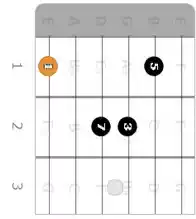
Dom 7 Chord
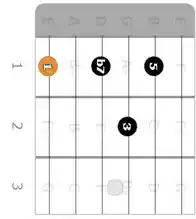
Min 7 Chord
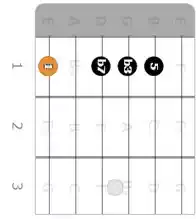
Difference Between Dominant 7th Chord And Minor 7 Chord.
If the Dominant and minor 7th has the same chord root, the difference between the two is only in the 3rd note, which is a Major 3rd in the dominant and a minor 3rd in the Minor 7 chord type. This is shown in the chord diagram above.
Consider the key of C. The degrees of minor triad chords are:
- ii – 2, 4, and 6 (D, F, and A) – Supertonic
- iii – 3, 5, and 7 (E, G, and B) – Mediant
- vi – 6, 1, and 3 (A, C, and E) – Submediant
Degrees 2 and 4 are often classified as the Predominant category. Degrees 3 and 6, the mediant and submediant, have two notes common with the tonic and are usually substituted for the tonic.
Adding a minor 7th note to these triads results in the following:
- ii7 – 2, 4, 6, and 1 (D, F, A, and C)
- iii7 – 3, 5, 7, and 2 (E, G, B, and D)
- vi7 – 6, 1, 3, 5 (A, C, E, and G)
Note that the iii7 chord has a leading tone and all the notes of a dominant triad. In some music theories, like the German theory derived from Hugo Riemann, the mediant of a major scale is considered to be a dominant parallel. But it lacks the tritone to really give it a dominant 7th function.
Note that the vi7 has all the notes of a tonic triad.
The difference between Dominant & Diminished Seventh Chords.
A half-diminished seventh chord (vii7b5) naturally occurs in major and minor keys at degrees 7 and 2, respectively. It has the notes at degrees (7, 2, 4, and 6) in a major key. Since it contains 7, 4, and 2 scale degrees with a leading tone and tritones, it is said to have a dominant function.
A full-diminished 7th chord has a lowered 7th from the half-diminished chord, and this double-flatted 7th is a chromatic note, not in the key.
How & When to Use a Dominant 7th Chord
The various functions of the dom7 chords are
- The dom7 chord has an enriched sound quality with color compared to the triad.
- The V – I progression in the root position is the Perfect Authentic Cadence signifying the end of the song or the composition. Usually, a dom7 chord is used in the ii – V – I progression for this purpose.
- They are used in the half cadences at the end of antecedent phrases to make the brain expect the music to continue to a final resolution.
- The dom7 chords can be used to establish the tonality of any key quickly.
- It can be used to create more intensity in any chord progression by adding tension.
- Composers use the concept of the strong relationship of the dom7 chords with the tonics to create non-tonic chords that resolve to scale degrees other than the tonic. This is done to emphasize the other chords, and the non-tonic dom7 chords for the purpose are known as the secondary dominants.
Common Chord progressions with dom 7’s
The dom7 chords are frequently used in blues progressions. The famous 12-bar blues progression is built upon the I – IV – V chords. The V chord is often replaced by V7, making it an I – IV – V7 progression.
Instead of the movement remaining as I – IV – V in the above 12-bar progressions, you can use a deceptive cadence and turnaround. This is usually played as I – IV – I – IV – V7 – IV – I – V7. The progression, instead of completing from V7 to I chord, detours via IV to I to V7. The next cycle starts thereon. Since it finishes at V7, the progression has a deceptive or half cadence, and since the last V7 turns again to I for the next phrase, it is called a turnaround or turnback.
Like the I – IV – V progression is a staple in rock music, the ii – V – I progression is a staple in Jazz guitar. Some more progressions are explained in the examples below.
Examples of Dominant Chords
The below section gives examples of popular songs with dom7 chords and explains how these chords have been used.
Songs that Use the Dominant 7th Chords
Some of the popular songs that use the dom chords are:
- “Heartbreak Hotel” by Elvis Presley uses I – I7 – IV7 – V7 – I. The song features an eight-bar blues progression.
- “Track of my tears” by Smokey Robinson, Warren Moore, and Marvin Tarplin, 1967. The song uses half cadences and full cadences alternatively through the I – IV – V7 – I – IV – I – IV – V7 – I progression repeatedly.
- “You can never tell” by Chuck Berry uses only I and V chords.
- “Jambalaya” by Hank Williams uses I – V7 – I repeatedly.
- “When a man loves a Woman” by Calvin Lewis and Andrew Wright, 1966 uses I – V7 – vi – I – I7 – IV – V7 – I. The V7 moves to vi and then to the I chord. It then uses its unstable variant I7 as a secondary dominant, which points to IV. The progression finishes at the I chord through V7.
- “Return To Sender” by Otis Blackwell and Winfield Scott, 1962 uses I – vi – IV – V7 – I. This progression has been used in countless songs. The progression gets its power from the two consecutive 3rds, I – vi and vi – IV, at the beginning. It can have a variation I – vi – ii – V7 – I.
- Some other good examples of the use of secondary dominants are the song – “Faith” by George Michael, “The Star-Spangled Banner” (U.S. national anthem), “Every Breath You Take” by The Police, and “Act Naturally” by The Beatles.
Dominant 7 Voicing
Let us now look at the various voicing of the dom7 chords.
Inversions
The root position chord with the notes (1, 3, 5, b7) has been discussed so far, and we will discuss their finger position in the section below on “How to play dom7 chords.”
The root and other inversions of the dom 7 chords can be played in the open position but are virtually unplayable in the closed position. Hence depending on which string the root is, the arrangement of notes has to be altered, keeping the bass note for the inversion fixed.
The used arrangements are:
- Bass Note in the fifth string: [1 5 b7 3]
- Bass Note in the sixth string: [1 b7 3 5]
- Bass Note in the fourth string: [1 5 b7 3]
We will discuss the finger positions in later sections.
1st Inversion or V6/5
The 1st inversion has the third as the bass note, and the note arrangement is [3 5 b7 1]. As stated, this is difficult to play, and usually, the following arrangements are used.
- Bass Note in the 5th string: [3 b7 1 5]
- Bass Note in the 6th string: [3 1 5 b7]
- Bass Note in the 4th string: [3 b7 1 5]
2nd Inversion or V4/3
The second inversion has the 5th note as the bass with the normal note arrangement [5 b7 1 3]. The used arrangements are:
- Bass Note in the 5th string: [5 1 3 b7]
- Bass Note in the 6th string: [5 3 b7 1]
- Bass Note in the 4th string: [5 1 3 b7]
3rd Inversion or V4/2
The third inversion has the 7th note as the bass with the normal note arrangement [b7 1 3 5]. The used arrangements are:
- Bass Note in the 5th string: [b7 3 5 1]
- Bass Note in the 6th string: [b7 5 1 3]
- Bass Note in the 4th string: [b7 3 5 1]
Drop 2 Voicing
Drop 2 chords are very frequently used in jazz music, so you don’t have to stretch your fingers too much. As you may be aware Drop-N voicing means that you have to lower the pitch of the Nth note from the highest (the top note) of any chord by one octave.
So the drop 2 voicing has the chord formula [5 1 3 b7]. Note that this is the same as the arrangement for the 2nd inversion with the bass note in the 4th and the 5th string.
Drop 3 Voicing
Drop-3 chord voicing lowers the 3rd note by one octave, resulting in the chord formula [3 1 5 b7]. This is the same as the 1st inversion with bass on the 6th string.
Drop 2 & 4 Voicings
Drop 2 & 4 dom7 chords have the formula [1 5 3 b7].
HOW TO PLAY DOM7 CHORDS
You can now look at the various guitar chord diagrams below, which will guide you on how to play the different dom7 chords along with the recommended finger positions.
Dominant Seventh Chords – Guitar Chord Charts
Let us begin with the open positions chord charts for the dom7 chords, which are easier to play for beginners.
Open Dom7 chords
The below diagrams show the open position charts for the chords with the natural notes as their root. The diagram does not include F7, as you cannot play it in an open position. Note that A and E can be played in two open positions.
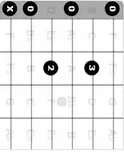
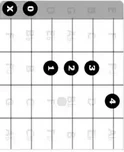
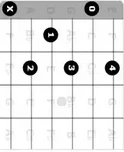
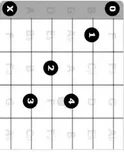
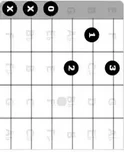
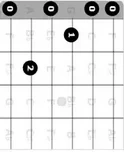
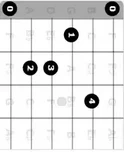
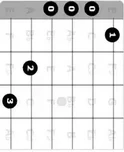
Moveable Dom7 chords
The movable dom7 shapes are shown with the root notes on the 4th, 5th, and 6th strings. On each of these, all three inversions of the root position are shown in different colors, with pink as the root inversion, green as the 1st inversion, blue as the 2nd inversion, and purple as the 3rd inversion.
In addition, for each of these, movable natural root note chords are shown along the fretboard in different frets. While playing the stings marked X, you must mute them or simply not play them.
Root Note on the Fourth String
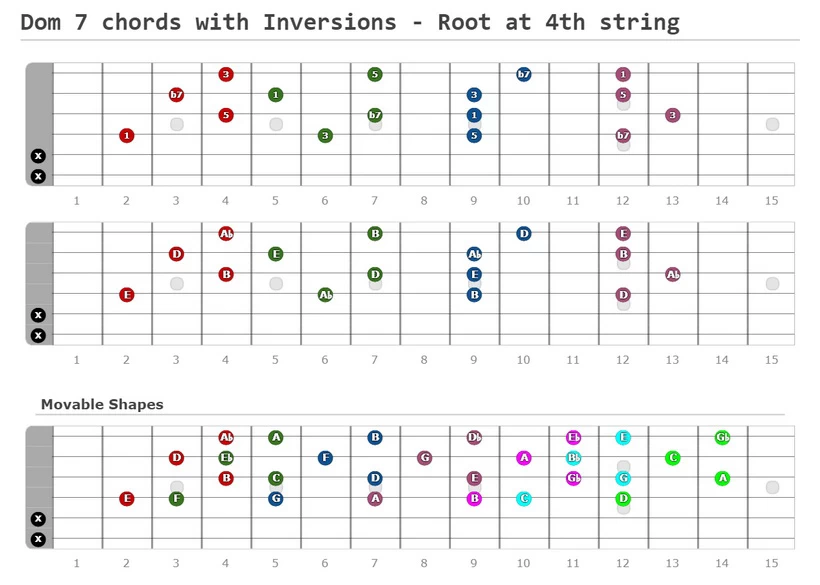
Root Note on the Fifth String
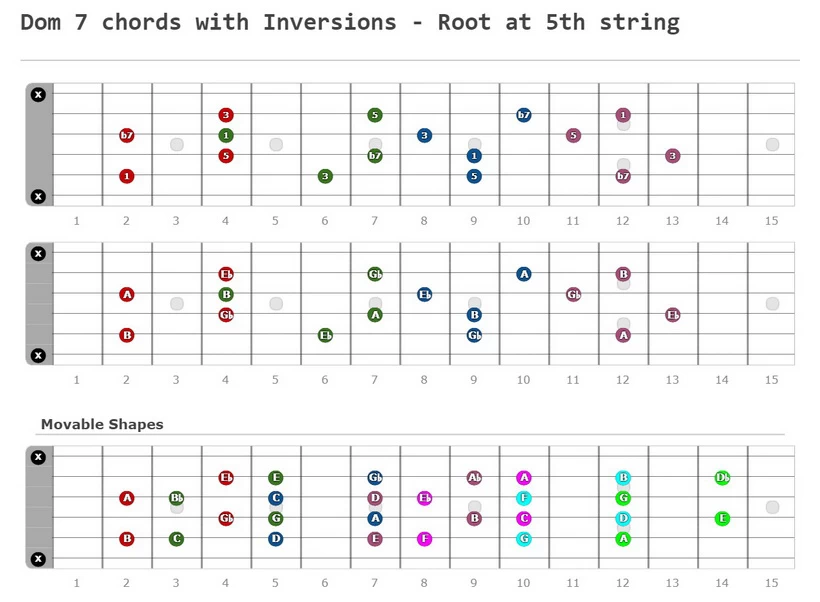
Root Note on the Sixth String
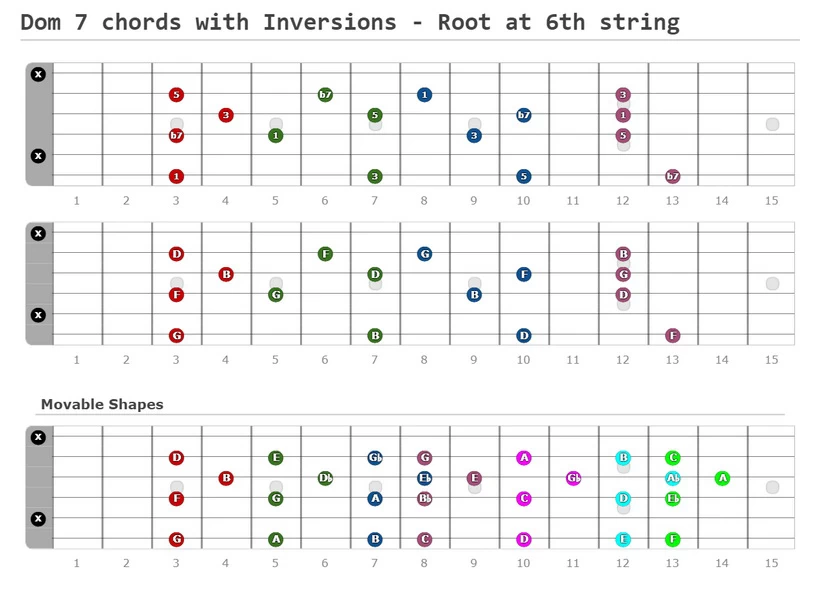
Conclusion
In this post, we’ve gone over dominant 7th chords: what they are, how to play them, and when to use them. We hope that this article has been helpful in your journey as a musician! If you have any questions or comments, please leave them below!
